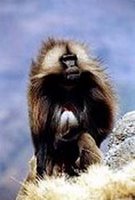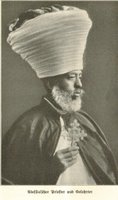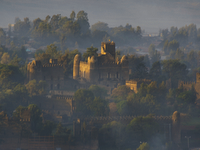
 Qaray
QarayAfar Sheruba
Tshefrer (Afro Goferay with a twist) and dreadlock combination
Afro of Afar People
Sheruba of unmarried Afar
Many types of hair styles exists in Ethiopia. Basically, braids (sheruba in Amharic), Afros (Goferay in Amharic) and dreadlocks of monks and pilgrims are common. In major towns however, the wonderful styles are not seen as common as in the rural areas. Most Ethiopians may proudly hang up photos of traditional hair styles in their homes but usually avoid wearing it themselves probably because they may be depicted as backwards. Many years ago The Ethiopian Post Office printed a set of stamps that depicted various tribes wearing unique and stylistic hair styles from the provinces of Arussi, Bale, Begemedir (Gonder), Eritrea, Shoa and Kaffa (double click for larger image). Some of these hair styles were actually used by the ancient Egyptians and Pharoahs and people of the Nile Basins. In fact there are many traditions and cultures used in Ethiopia that are presently absent in other parts of the Nile valley such as Head Rests, Cistrums, Ear wax cleaners and reed Rain Coats are still used in Ethiopia. Interestingly, the Ice Man found in the Alps of Italy used a similar Reed Rain Coat though he used it as a sleeping mat as do the Ethiopians! The hair styles shown here are from the stamps printed many years ago by the Ethiopian Post Office

Men usually have a hair style in the Afro fashion. However, they are known to also braid their hair. A well known examples of braids in men is that of Emperor Tewodros and Yohannes. This style is common among the Amhara of Ethiopia depicted on the left.

Hair styles also exists for the young. Mischievous toddlers receive a Mohawk type of hair cut. The Amharic name for this style is "Kuntcho". The traditional story behind this style is that the angels will pull the kids out of trouble by holding onto the tuft of hair of the kids. An example is the kid on the left. Young girls receive a hair cut that includes a shaved top surrounded by a halo of an Afro style. The girl on the left probably has this type of hair style but whether the top is shaved is not visible

Traditional hair style of Emperess Taitu, wife of Emperor Menilik.
This Subject is constantly being Updated...please be patient! Feedbacks appreciated!
Hairstyles of Ethiopia
Hairstyles for Children
Quntcho: This hairstyle is used mostly in toddlers and the very young. It consists of a tuft of hair on top of a shaved head. In Ethiopian tradition, the angels save the child from mischief and trouble by holding them by the tuft of the Quntcho hair. This Quntcho style however is disappearing in large towns but it is still common in rural Ethiopia where it is a sign of tradition and not backwardness.
Zerantch: The hair of the Quntcho that grows on the head of a child is called Zerantch.
Qaray: A narrow strip of hair is allowed to grow from the mid-forehead to the back of the neck. The rest of the head is shaved. This style of hair is known as a Mohawk in the United States of America. However, within Ethiopia, it has been practiced as a tradition for many centuries in young boys. A well known Hollywood actor with a famous Qaray is the African American actor known as Mr. T. However, Mr. T also has an extra pair sticking out of his temples! It should be emphasized that Qaray is a hairstyle for children not for the sexually mature and married individual. In the United States, the Mohawk in African Americans is sometimes called Black Mohawk or Fro Hawk. Fro stands for Afro. This style is used in both sexes.
Sheruba: Sheruba is braid whether it is braided as a cornrow or as a free-hanging braid.
Sadula: Teenager maidens shave their hair on the top of the head and leave the outlying fringes unshaven. The shaven hair is allowed to grow only after the women have matured and married. The first growth of this shaven hair after marriage is called Endermamit or Fesesay The hair that has not been shaved, that is, the outlying fringe, is either braided or combed into an Afro. The Sadula is practiced mostly by the Amharas and Tigreans and some other tribes of Ethiopia.
Gamay: The Gamay is similar to a Sadula hairstyle used by girls.
Zur Gamay: This hairstyle is another name for Gamay Sheruba worn by young unmarried girls. It is also similar to the hairstyle known as Sadula.
Gamay Sheruba: This hairstyle is a Sadula hairstyle using braids. Unmarried girls shave the top part of the head and braid the remaining hair surrounding the bald spot.
Endermamit: When a young virgin girl with a Sadula hairstyle has married, the one year growth of new hair from the previously shaved area is called Endermamit. It is customary to comb this new growth with great respect.
Fesesay: This term is identical with Endermamit. When a young virgin girl with a Sadula hairstyle has married, the one year growth of hair that she combs and takes care of is called Fesesay.
Hairstyles for Women
Sheruba:
Sheruba: Hair that is braided into a cornrow or as a free-hanging braid.
Gadeiray: This is a type of braided hairstyle by Amhara people.
Gofeiray: Any type of hairstyle that involves the excessive growth of woolly hair. In the West it is known as an Afro. This hairstyle is also used by women.
Gufta: Gufta is a hairstyle commonly practiced by the Oromo and Gurage people in Ethiopia. Basically, the hair is combed into a fluffy Goferay (Afro). It is then neatly covered with a shash and tied at the rear.
Eshem: This hairstyle is a thick large braid worn by women mostly but also by men in the older days. It is actually a large corn row beginning from the forehead and ending at the back of the neck. Tradition does not dictate as to the number of corn-row braids but Eshem is convenient for those who cannot stand the long hours of fine cornrow braiding. Gungun is another type of Eshem.
Eshem Dereb: This name implies a Double Eshem. This is a type of Eshem that involves the creation of one large Eshem over the top of another.
Gungun: This is a type of Eshem braid. It is a hurriedly prepared hairstyle to suit those who do not have time for an elaborate time-consuming cornrow braidng of the hair.
Mertu: This hairstyle is traditional amongst the Ethiopian Oromo people. The hair is braided in a rope-like fashion (twisted around) and ends in a tuft of hair. This is not done in the fashion of a cornrow. In most cases the hair and scalp is conditioned with ghee (an organic conditioner commonly practiced by Ethiopians) giving the hairstyle a glossy appearance. Mertu is also practiced by other ethnic groups such as the Gurage where it is also weaved like a rope. The hair is allowed to hang down freely.
Sadula: Teenagers, virgins and unmarried maidens shave off the hair on top of the head and leave the outlying fringes unshaven. The hair is allowed to grow only after the women have married. The hair that has not been shaved, that is, the outlying fringe, is either braided or combed into an Afro. The Sadula is practiced mostly by the Amharas and Tigreans of Ethiopia.
Endermamit: When a young virgin girl with a Sadula hairstyle has married, the one year growth of new hair from the previously shaved area is called Endermamit. It is customary to comb this new growth with great respect.
Fesesay: This term is identical with Endermamit. When a young virgin girl with a Sadula hairstyle has married, the one year growth of hair that she combs and takes care of is called Fesesay.
Hamar Bumi and Karo (Southwestern Ethiopians) Women Hairstyle: Hamar Bumi and Karo Ethiopian women who are unmarried have their hair rubbed with fat into small balls then cover them with ochre. These women change their hairstyle after marriage by changing the balls into long twisted strands rubbed in ochre. A fancy decorative ornament usually is included in the hairdo.
Afar Women Hairstyle: Afar (Danakil, Dankali) women that are unmarried wear their hair as hanging ringlets. After marriage, these women cover their hair with Shash or mushal.
Gerdaba Shash: A type of shash that covers the hair and used mostly by by Oromo women. The hair is usually combed as an Afro first then covered with the shash (Shash in Amharic).
Qelbay Shash: This is similar to the Gerdaba Shash but is a term in Amharic.
Kebs: this is a head and hair cover used by women and priests
Gutena: A type of Goferay, an Afro hairstyle.
Hairstyles for Men
Goferay: Any type of hairstyle that involves the excessive growth of woolly hair. In the West it is known as an Afro. This hairstyle is also used by women.
Hamar Bumi and Karo Hairstyle (Southwestern Ethiopians): Hamar Bumi and Karo men wear clay hair buns representing killing of an enemy or a dangerous animal. The hairdo lasts up to one year. Above the forehead, a small holder is made to hold ostrich feathers. Hamar men also braid their hair into cornrow.
Afar Hairstyle: Afar (Danakil, Dankali) men frizzle their hair into a fuzzy mop (so-called Fuzzy Wuzzy of the British). When ringlets are desired, ghee is used to soften the hair into the desired fashion.
Tchefrer (Fuzzy Wuzzy): The Tchefrer (or Fuzzy Wuzzy is a term created by the British and is only mentioned here as a historical note) is well known by patriots, Monks and Spiritualists (Qalitcha). The Ethiopians in the borderlands near the Red Sea were well known to be described as the Fuzzy Wuzzy people. The Beni Amir, Besharin, Amrar, Bilen, Afar, Saho, Hadendowa as well as others exhibit an unusual exaggerated Afro. Some of these tribes still wear this hairstyle. The Fuzzy Wuzzies gave these people a fierce appearance to their enemies. It should be mentioned here that these people were not conquered since the Roman times. When the British first encountered them, they aptly called them Fuzzy Wuzzies not knowing their culture language or origin. Previous to that the Romans and Greeks considered them as apes who resided in the ground and classified them as Troglodytes. The nearest Ethiopian word for Fuzzy Wuzzy is Tchefrer which means unkept frizzled hair worn by Patriots, Monks and Spiritualists.
Nazrawi: This is a Christian monk who wears his hair in a Goferey (Afro style combined with dreadlock) and wraps a long chain several times around his shoulders and waist. This monk or pilgrim also carries a long metal rod that is topped with the crucifix (cross). Nazrawi in itself is not a hairstyle but is mentioned here as an information about Nazrawi monk hairstyle.
Keloita; this is a skullcap worn by men of the Islamic faith.
Buqedaday; Elephants in Ethiopia were plentiful in the past centuries. An elephant killer (Zehon Gedaye) proudly showed their status by wearing the Buqedaday shash (head band) as a sign of valor. The narrow sash, usually green yellow and red (The Ethiopian National Symbol) over a white background, covers part of the forehead and was tied at the back of the head near the nape. An extra piece of the sash usually dangled down the back from the knot.




















11 comments:
thank you, this was beautiful to see, and very informative.
I love these photos. Ethiopians have an amazing cultural heritage, as do all Africans. Thank you for sharing and reminding the world of how beautiful we all are.
pretty weird hairstyles if u luk at them
Very beautiful and informative. I want to try some of theses styles. Some of them look a little hard though. There should be a how to book for non Ethio folks.
waaw look at them.. they are original... by they on style. amazing really amazing
i like them
Some good points raised in that post. Will be back to check for more.
Cheers,
hairstylesfree.com
It is imperative that we read blog post very carefully. I am already done it and find that this post is really amazing.
Cute hairstyles
it's very unique and beautiful... thanks for sharing the ethiopian cultures...
amazing! Beautiful cultural heritage, thank you for informing us
This article is quite creative. Thanks for the information.
Are you exploring a hair braiding near me? Visit our saloon to know all options we have to brighten up your look with our stylish hairstyles!
Post a Comment